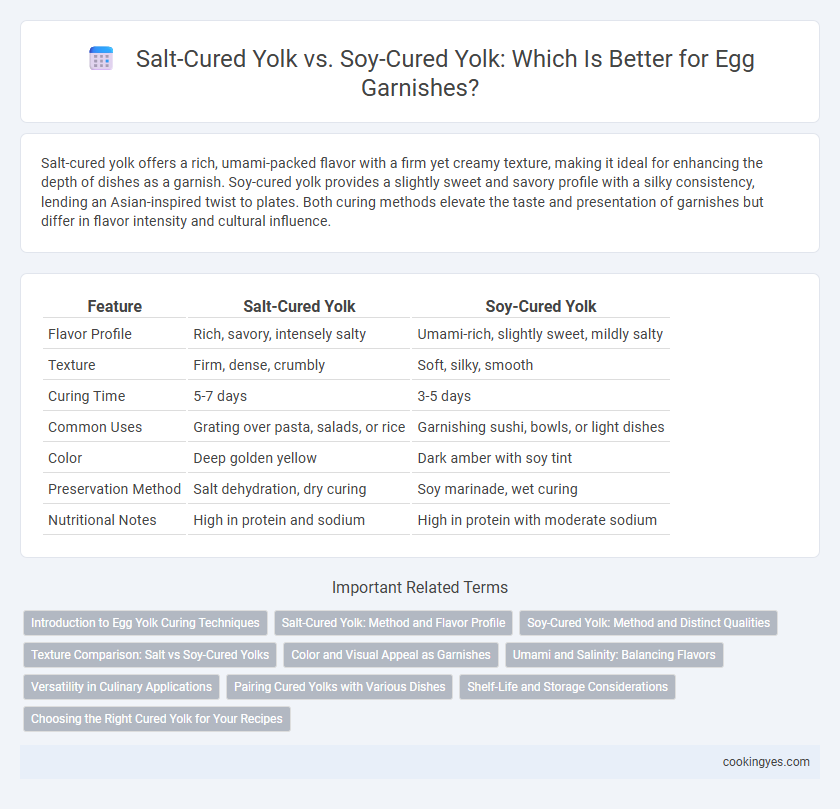Salt-cured yolk offers a rich, umami-packed flavor with a firm yet creamy texture, making it ideal for enhancing the depth of dishes as a garnish. Soy-cured yolk provides a slightly sweet and savory profile with a silky consistency, lending an Asian-inspired twist to plates. Both curing methods elevate the taste and presentation of garnishes but differ in flavor intensity and cultural influence.
Table of Comparison
| Feature | Salt-Cured Yolk | Soy-Cured Yolk |
|---|---|---|
| Flavor Profile | Rich, savory, intensely salty | Umami-rich, slightly sweet, mildly salty |
| Texture | Firm, dense, crumbly | Soft, silky, smooth |
| Curing Time | 5-7 days | 3-5 days |
| Common Uses | Grating over pasta, salads, or rice | Garnishing sushi, bowls, or light dishes |
| Color | Deep golden yellow | Dark amber with soy tint |
| Preservation Method | Salt dehydration, dry curing | Soy marinade, wet curing |
| Nutritional Notes | High in protein and sodium | High in protein with moderate sodium |
Introduction to Egg Yolk Curing Techniques
Salt-cured egg yolks transform raw yolks into savory, firm garnishes through dehydration and seasoning, intensifying umami flavors. Soy-cured yolks infuse a subtle sweetness and rich umami by marinating yolks in soy sauce blends, creating a tender texture ideal for delicate toppings. Both curing techniques enhance egg yolks' versatility in culinary applications, offering distinct taste profiles and textures for sophisticated presentations.
Salt-Cured Yolk: Method and Flavor Profile
Salt-cured yolk involves curing egg yolks in a mixture of salt and sometimes sugar for several days, resulting in a firm, cheese-like texture perfect for grating over dishes. This curing process intensifies the yolk's natural umami flavor, imparting a rich, savory, and slightly briny taste that enhances pasta, salads, and rice bowls. Salt-cured yolks offer a concentrated depth of flavor distinct from the sweeter, more subtle notes found in soy-cured yolks.
Soy-Cured Yolk: Method and Distinct Qualities
Soy-cured yolk is prepared by submerging egg yolks in a mixture of soy sauce, sugar, and mirin for several hours to days, allowing the flavors to deeply penetrate the yolk while coagulating it to a custard-like texture. This curing technique imparts a rich umami intensity and subtle sweetness, creating a balance that enhances garnishes with complex savory notes. The firm yet creamy texture of soy-cured yolks makes them ideal for finely slicing or grating over dishes, distinguishing them from the salt-cured yolk's firmer, drier profile.
Texture Comparison: Salt vs Soy-Cured Yolks
Salt-cured yolks develop a firm, dense texture with a slightly crumbly consistency ideal for grating over dishes, enhancing umami without adding moisture. Soy-cured yolks retain a softer, more gelatinous texture due to the moisture content in soy sauce, providing a rich, velvety mouthfeel that complements creamy or delicate garnishes. The contrast in texture between salt-cured's dry, granular crumb and soy-cured's moist, tender gel influences their culinary applications in garnishes.
Color and Visual Appeal as Garnishes
Salt-cured yolks develop a deep, amber hue with a slightly glossy surface, enhancing the visual richness and warmth of dishes. Soy-cured yolks exhibit a darker, mahogany tone with a subtle sheen that adds an elegant, umami-rich contrast to garnishes. Both methods create distinctive color profiles that elevate the presentation and appeal of culinary creations.
Umami and Salinity: Balancing Flavors
Salt-cured yolk delivers intense umami with a pronounced, straightforward salinity that enhances savory dishes without overpowering other flavors. Soy-cured yolk provides a complex umami profile enriched by fermentation, combining moderate saltiness with subtle sweetness and depth. Balancing these garnishes depends on desired flavor intensity, where salt-cured yolk offers boldness and soy-cured yolk introduces layered, nuanced taste.
Versatility in Culinary Applications
Salt-cured yolks offer a rich, umami flavor and firm texture that enhances pasta, salads, and rice dishes with a concentrated savory depth. Soy-cured yolks provide a slightly sweeter, savory profile with a subtle tang, lending complexity to Asian-inspired dishes, sushi, and modern fusion cuisine. Both curing methods yield versatile garnishes that elevate the taste and presentation of appetizers, main courses, and snacks.
Pairing Cured Yolks with Various Dishes
Salt-cured yolks offer a rich umami flavor and firm texture that pairs exceptionally well with savory dishes like pasta, salads, and roasted vegetables, enhancing their depth without overpowering. Soy-cured yolks bring a slightly sweet, saline complexity with an Asian-inspired profile, making them ideal for sushi, rice bowls, and grilled meats where their nuanced taste complements soy-based sauces and marinades. Both curing methods intensify the yolk's savoriness, allowing for versatile garnishing options that elevate the overall flavor of diverse culinary creations.
Shelf-Life and Storage Considerations
Salt-cured yolks offer a longer shelf-life, typically lasting up to several months when stored in an airtight container in the refrigerator, making them ideal for extended use in garnishes. Soy-cured yolks, while providing a unique umami flavor, generally have a shorter shelf-life of about two weeks and require refrigeration to maintain freshness and prevent spoilage. Proper storage conditions, such as low humidity and stable cold temperatures, are essential for preserving the texture and flavor integrity of both curing types.
Choosing the Right Cured Yolk for Your Recipes
Salt-cured yolks deliver a concentrated umami flavor with a firm, cheese-like texture ideal for grating over pasta or salads, enhancing savory dishes without overpowering. Soy-cured yolks offer a slightly sweeter, more complex taste profile with a tender, creamy consistency that complements Asian-inspired dishes and adds depth to sauces. Selecting the right cured yolk depends on the desired flavor intensity and dish style, with salt-cured yolks providing bold, salty notes, while soy-cured variants bring subtle sweetness and rich umami.
Salt-cured yolk vs Soy-cured yolk for garnishes Infographic

 cookingyes.com
cookingyes.com